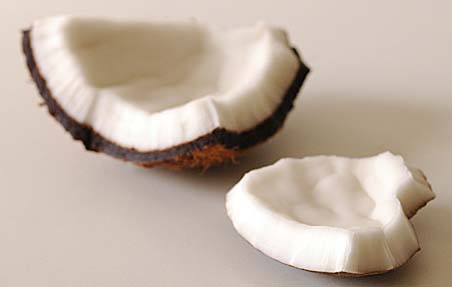“But isn’t coconut high in saturated fat,” you ask? Well, yes, kind of, but its saturated fat is in the form of a medium-chain fatty acid (mcfa) called lauric acid. Lauric acid acts as a natural anti-viral, microbial, and fungal compound when consumed. This mcfa makes up 50 percent of coconut oil and provides a great, natural way to fight any impending bacterial or viral agents. If you’re still not convinced coconut’s fat content is healthy, consider the fact that the only other natural source for lauric acid is in breast milk which contains all nutrients needed to feed an infant.
Combine it with cinnamon, cardamom, ginger, cloves, garlic cumin, coriander, and turmeric for a flavorsome way to promote healthy digestion and boost metabolism. As a way to increase the size of (fatten) their cattle, farmers tried feeding them coconut oil back in the 1940’s. But, instead of gaining weight, the cattle became more active with an increased appetite and a leaner body composition.
 Consequently, this effect has been found to have the same reaction in humans. Coconut oil’s mcfa's increase the metabolism through thermogenesis (calories burned from digesting food), which helps both animals and humans lose fat and keep it off. Unlike some vegetable oils, coconut oil is stable at high heat and can resist any damage to its beneficial components. Keep in mind that any “health” benefits from other oils are wiped out and they actually become toxic when exposed to high heat. Stick to using extra virgin olive oil on salads and other non-heated dishes to obtain its benefits.
Consequently, this effect has been found to have the same reaction in humans. Coconut oil’s mcfa's increase the metabolism through thermogenesis (calories burned from digesting food), which helps both animals and humans lose fat and keep it off. Unlike some vegetable oils, coconut oil is stable at high heat and can resist any damage to its beneficial components. Keep in mind that any “health” benefits from other oils are wiped out and they actually become toxic when exposed to high heat. Stick to using extra virgin olive oil on salads and other non-heated dishes to obtain its benefits.Try using extra-virgin coconut oil in place of olive and vegetable oils for cooking or baking recipes. Add canned coconut milk (not the SO Delicious stuff in a carton) to your favorite smoothies or in mixed with sweet potatoes simmered in a sauce pan. Kelley and I love eating coconut rice alone or with tuna, beans or chicken.
Here’s an easy coconut rice recipe found at http://allrecipes.com/Recipe/Coconut-Rice/Detail.aspx
Ingredients
1-1/3 cups and 2 tablespoons Basmati rice
2-1/4 (10 ounce) cans coconut milk
5/8 pinch salt
Directions
This recipe's Ingredients were scaled to yield a new amount. The directions below still refer to the original recipe yield of 6 to 8 servings.
1. In a large saucepan over high heat, combine rice, coconut milk and salt; bring to a boil.
2. Reduce heat, cover and simmer for 20 to 25 minutes, or until liquid is absorbed and rice is tender.
Try buying a whole coconut and using one of these methods to get inside to the flesh and water.
I found it easier and more enjoyable than expected by using method #1. Once open, I decided to make coconut milk following the instructions presented on http://www.marksdailyapple.com/coconut/.
This was really delicious and created a sense of accomplishment (and victory!) for having opened and processed my own coconut. Make sure to save a few small chunks to experience the flavorful flesh.
Whether whole or in one of its many prepared forms, I hope you enjoy adding coconut to your diet. Remember, there can be too much of a good thing, so don’t go eating coconut oil by the spoonful. Just try mixing things up and using in place of other ingredients to derive the benefits offered from all whole foods.


-286177.jpg)



 Coconut
Coconut
No comments:
Post a Comment